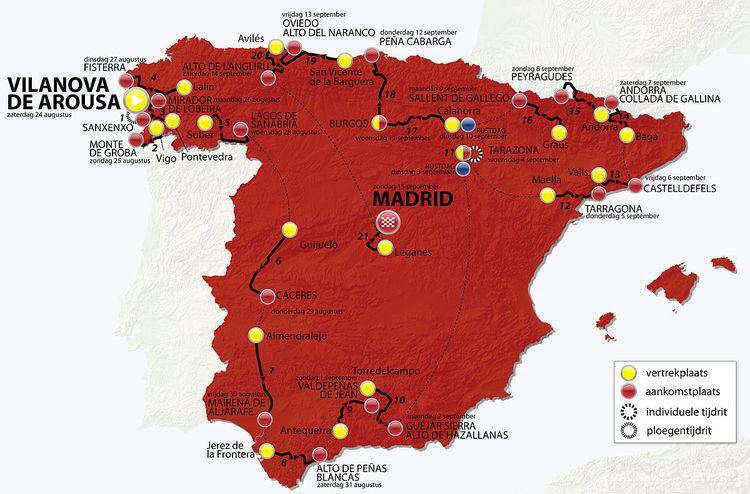Stages 21 Winning time 84h 36' 04" | Distance 3,358.9 km (2,087 mi) | |
 | ||
Dates 24 August – 15 September | ||
The 2013 Vuelta a España was the 68th edition of the race.
Contents
This Vuelta started in Galicia on August 24, 2013. The race spent 5 days in Galicia, then continued anticlockwise touring Spain through Castile and León, Extremadura, Andalusia, Aragon, Catalonia, La Rioja, Cantabria, and Asturias, before returning to Madrid for the finish on September 15. The Vuelta included excursions into two neighboring countries, Andorra and France. The top three stage winners received the following bonuses in the general classification: 10 seconds for winners of the stages, six seconds for runners-up, and four seconds for those in third place.
Chris Horner won the 2013 Vuelta at the age of 41 on the 15 September 2013 becoming the oldest ever Grand Tour winner. Horner beat his nearest challenger, Italian Vincenzo Nibali by finishing ahead of him in each of the final three mountainous stages before the final stage into Madrid.
Teams
The 19 UCI World Tour teams were automatically entitled to start the race; three wildcard teams were also invited.
†: Invited Pro-continental teams
Race overview
For details see 2013 Vuelta a España, Stage 1 to Stage 11 and 2013 Vuelta a España, Stage 12 to Stage 21
Classification leadership table
There were four main classifications contested in the 2013 Vuelta a España, with the most important being the general classification. The general classification was calculated by adding each cyclist's finishing times on each stage. The cyclist with the least accumulated time was the race leader, identified by the red jersey; the winner of this classification was considered the winner of the Vuelta. In 2013, there were time bonuses given on mass-start stages; ten seconds were awarded to the stage winner, with six for second and four for third.
Additionally, there was a points classification, which awards a green jersey. In the points classification, cyclists get points for finishing among the best in a stage finish, or in intermediate sprints. The cyclist with the most points led the classification, and is identified with a green jersey. There was also a mountains classification. The organisation categorised some climbs as either hors catégorie, first, second, third, or fourth-category; points for this classification were won by the first cyclists that reach the top of these climbs, with more points available for the higher-categorised climbs. The cyclist with the most points led the classification, and was identified with a blue polka dot jersey.
The fourth individual classification was the combination classification, marked by the white jersey. This classification is calculated by adding the numeral ranks of each cyclist in the general, points and mountains classifications – a rider must have a score in all classifications possible to qualify for the combination classification – with the lowest cumulative total signifying the winner of this competition.
For the team classification, the times of the best three cyclists per team on each stage were added; the leading team is the team with the lowest total time. For the combativity award, a jury gives points after each stage to the cyclists they considered most combative. The cyclist with the most votes in all stages leads the classification. For the daily combative winner, the rider in question donned a dossard with a red background, on the following stage.
